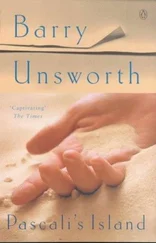The rush of relief these words released in Somerville made him unsure he could control his voice if he tried to speak. He fell to studying the lid of the sarcophagus. It was sealed with bitumen, he saw now. “We’ll need a sharp, thin-bladed knife,” he said, restored to self-control by this practical consideration. “Preferably with a serrated edge. Would you go up and ask Elias to find one for us?”
He made no further attempt to examine the sarcophagus while he waited but stood without moving in the center of the room, feeling the silence of the place settle over him. Two names. It was unusual; in fact he had never heard before of an Assyrian king and his consort laid in the same coffin or even in the same tomb. The royal women were buried at home below the domestic wing of the palace; the kings were customarily taken to Ashur, dwelling place of the father-god, for burial. But the city had gone up in flames, and the god Ashur made captive and led away on a cart in 614; it had been the first of the Assyrian power centers to fall. The tomb must have been built well after that. He could not recall the name of Sin-shar-ishkun’s queen; perhaps he had never known it.
When Palmer returned with Patricia, they were accompanied by Edith. A few minutes later Elliott, Manning, and Spahl arrived; it seemed that these three had walked over together. Somerville waited until everyone was assembled and the lamps were set around the wall. Then he set to work with the knife Palmer had brought. It was easier than he had thought, there was hardly need for sawing; the bitumen was brittle, the seals parted one after the other as Elliott and Spahl, standing on either side of him, eased up the lid very slightly at the points where the knife was inserted.
“We are ready to take the lid off now,” Somerville said. “It will probably need four of us at least. I’d just like to say a few words first. I wanted you to be present so that if questioned about the authenticity of these proceedings you will be able to give eyewitness accounts. Mr. Spahl, in particular, as a journalist of considerable standing, might be willing to bring the discovery before a wide readership, might even be glad to be the first to do so.”
“Indeed yes,” Spahl said. “A scoop of big proportions, my paper will be greatly pleased.”
“I feel it is important for you to be informed of the facts, as far as Palmer and I have been able to establish them. The name on the sarcophagus is the same as that over the doorway to the tomb, it is the name of the last king in the line of Sargon, effectively the last king of Assyria. There is a name alongside it, a woman’s name.”
“I can manage to make it out now,” Palmer said. “It is Lattalia.”
Somerville went on to speak of the doubts that hung over the final fate of this king, the time and place of his supposed death. He told them of his own first belief that this must be an impostor. “Impostors were not uncommon in ancient Assyria,” he said, “especially in times of crisis or extreme danger, when the king might temporarily bestow his identity—and his name—on another. There are precedents for this, historically documented. If you will bear with me a few minutes longer, I will tell you what I think might have happened. In the summer of 612 B.C. the Assyrian Empire was in its death throes. Ashur, the religious capital, had been destroyed two years earlier. Now the siege was tightening around Nineveh, the administrative heart, the seat of government. Sin-shar-ishkun, whose name is on this sarcophagus, decided to give that name to someone else. The true name of the man he chose is not recorded anywhere as far as I know. I think it probable that he was some high military commander—a reasonable choice at a time like that.”
He paused on this and smiled a little. He had visibly relaxed in posture as he talked; it was now as if he were delivering a lecture to a group of students. None of his hearers had made the slightest sound or the slightest shift of position. None of them had taken their eyes from him. He is in command of us, Edith thought. As if we were children, listening to wonders. Such different kinds of people, yet we are all in the grip of his words, in the grip of this story he is telling. She had never seen her husband as a man with a gift for storytelling. And it was more than that, much more: His voice was quiet, but there was authority in his words, a kind of power emanated from him. And there was nothing assumed, nothing theatrical; he was entirely himself.
“So for a while there was a king in Nineveh who was not the true king. The true king escaped the siege, fled here with the belongings he valued most. Among these was a statuette of Marduk, the god of the Babylonian enemy, who he hoped might protect him. With him came queen and concubines, servants and guards, followers ready to cast their lot with him. We know now that this place was a residence, probably a summer palace, of the Assyrian kings, at least for a century or so—since the time of Esarhaddon. We have found definite proof of this. So here the king lived quietly under his borrowed name for some time longer, perhaps some years, far to the west of the Assyrian heartlands on the Tigris. This vaulted tomb and the sarcophagus were made ready on his orders, and when the time came for him to be laid to rest, he had Marduk installed in the entrance chamber as a guardian. Perhaps we can try raising the lid now. There is no room behind it, but if Elliott and Manning can take the sides, the rest of us can try to lift it from the front and rest it back against the wall.”
It took all five of the men, straining with the effort and the need for care, to raise the lid and get it propped securely resting on its edge. In this combined effort, and in the wonderment of looking down into the coffin—they were the first to do this—these men were as one, bound together in a common sentiment for the first time and the last.
Edith and Patricia came forward now and joined the men, and all stood close together there, looking down. The two skeletons lay side by side. They had died, or been laid in death, on their backs; the caverns where their eyes had been seemed in that inconstant light of the lamps to have retained some power of seeing, to be returning the gaze of the spectators. The flesh had long gone, but the framework of bone was perfectly preserved; no hand had touched it. Only the teeth were ruinous.
“They have been lying here for about twenty-five hundred years,” Somerville said, breaking the long silence. She had been shorter than her burial companion by a foot at least, but the two skulls were on an exact level, he noticed now. As if they had lain with faces close, he thought. But of course they must have died outside the coffin. Perhaps the king gave orders that they should be laid with their faces touching. “Queen or concubine, no way of knowing for the moment,” he said. There was a shared headrest of what looked like filigree gold lying beneath the skulls. The dust of their decay lay around them, and a scattering of beads from the necklace she had worn, more than one necklace probably. The beads were numerous and of different types and coloring; he caught the glint of gold among them. Other jewelry he saw in this first quick, surveying glance: fibulae, armlets, a pendant with a thin chain. There were three rings on the man’s right forefinger. Priceless, these objects. He felt a surge of protectiveness almost violent in its nature. The others were standing too close; he would have liked to shift them away. “We’ll get a covering made,” he said to Palmer.
It was Patricia, striving in typical fashion to combat the awe that had descended on her, who came up now with a question that brought them back from the violated privacy of these bones to time and event. “The man he gave his name to,” she said. “What became of him?”
Читать дальше











